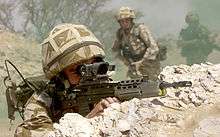Saif Sareea II

Exercise Saif Sareea II, Arabic for "Swift Sword II", was a major military exercise in September and October 2001 involving the military of the United Kingdom and Oman. It was the largest single deployment of UK forces since the Gulf War.[1] Over 22,500 personnel, 6,500 vehicles, 21 naval vessels, 49 fixed-wing aircraft and 44 helicopters were deployed; compared with the previous largest force of around 5,000 personnel.[2] In addition over 11,000 Omani forces took part.
Objectives
- To test the UK's expeditionary warfare strategy, particularly the effectiveness of the tri-service Joint Rapid Reaction Force.
- Highlight shortcomings in equipment and practices of such a deployment
- Provide training
- Support foreign policy objectives (co-operation and maintain relationships with allies in the Persian Gulf region)
Results

This exercise illustrated a number of problems in the British Army; the traditional "make-do" attitude to shortages of modern equipment and essential spares fell down in the face of the Omani weather.
- Soldiers reported their uniform was too hot and those who had not been issued with desert boots suffered from foot problems as their combat boots melted in the heat.[3]
- The 66 Challenger 2 tanks suffered from poor reliability. This was not due to any inherent defect with the tank, but rather due to the failure of the Army to adequately 'desertise' the tanks (apparently on grounds of cost). The failure to fit appropriate filters led to substantial engine damage due to the ingress of sand and dust. Two squadrons of tanks were withdrawn from the exercise.[4]
- The SA80A1 rifle (the unmodified variant) suffered stoppages and jamming due to sand and dust ingress.[4]
- Westland Lynx helicopters became unserviceable as their rotor blades' flying time was reduced from 500 hours to 27 hours.[4]
- The Clansman radio system performed so poorly it was judged "incapable" of operating in combat.[4] Unable to communicate by radio and with no mobile phone service, tank commanders had to pull up during manoeuvres to check orders with each other.[4]
- Plastic filters on the AS-90 self-propelled artillery melted in the heat, rendering the gun useless.[4]
- Some of the Army's trucks were so old that the only way to keep the engines from overheating was to turn the cabin heaters on full, which meant the drivers had to get out every few minutes because of the heat.[4]
Some of these problems - mostly with Challenger 2 and the AS-90 self-propelled gun were fixed in time for the invasion of Iraq in 2003.
Some equipment performed extremely well in the operation.
- The recently introduced C-17 provided a level of strategic lift not previously available to the RAF.
A report by the National Audit Office stated that "given that the joint rapid reaction forces are intended to be able to operate anywhere in the world, it is a concern that the MoD does not hold sufficient stocks of desert combat suits to equip the Forces." Despite these myriad problems, the MoD called the exercise a "success" and said that "the key point of major exercises is that they allow us to identify the challenges our forces might face when actually operating in such testing conditions. We have made comprehensive arrangements for identifying lessons and, where necessary, we will make improvements to our equipment and procedures."[4]
Equipment
Royal Air Force

- Tornado GR4
- Harrier GR7
- Tornado F3
- Chinook
- E-3 Sentry AEW
- Puma helicopter
- Lockheed C-130 Hercules
- Vickers VC10
- Nimrod MR2
Royal Navy
- HMS Illustrious (Aircraft carrier)
- HMS Ocean (Landing Platform Helicopter)
- HMS Fearless (Landing Platform Dock)
- HMS Cornwall (Type 22 frigate)
- HMS Marlborough (Type 23 frigate)
- HMS Monmouth (Type 23)
- HMS Southampton (Type 42 destroyer)
- HMS Nottingham (Type 42)
- HMS Inverness (Mine Countermeasures Vessel (MCMV)
- HMS Cattistock (MCMV)
- HMS Quorn (MCMV)
- HMS Walney (MCMV)
- HMS Beagle (Coastal Survey Vessel)
- HMS Roebuck (Hydrographic Survey Vessel)
- RFA Fort Victoria (Auxiliary Oiler Replenishment)
- RFA Fort Rosalie (Stores Ship)
- RFA Sir Tristram (Landing Ship Logistic)
- RFA Sir Galahad (Landing Ship Logistic)
- RFA Sir Percivale (Landing Ship Logistic)
- RFA Sir Bedivere (Landing Ship Logistic)
- RFA Oakleaf (Support Tanker vessel)
- FA2 Sea Harrier
- Sea King HAS Mk6
- Sea King Mk4
- Gazelle AH1
- Lynx Mk7
- Sea King AEW Mk 2
References
- ↑ Operation Veritas - Armed Forces deployments: The Armed Forces Minister's statement in the Commons
- ↑ "Top Guns". Oman Economic Review. United Press and Publishing, LLC. Retrieved 9 May 2011.
- ↑ BBC World news, 16 January 2003; Soldiers 'having to buy own kit'
- 1 2 3 4 5 6 7 8 Philip Johnston (1 August 2002). "Tanks, guns and boots all failed Army in desert". The Daily Telegraph. Retrieved 18 March 2016.
External links
| Wikimedia Commons has media related to Exercise Saif Sareea II. |